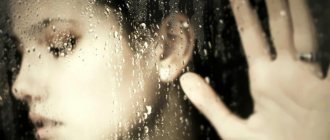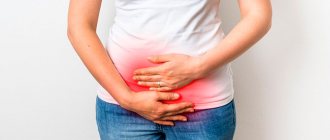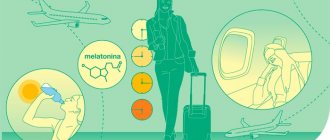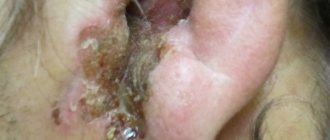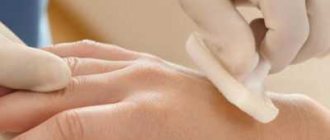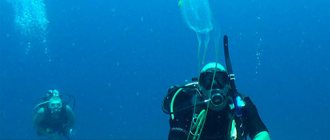Signs of a wasp sting
A wasp sting can be recognized by three main signs:
- very sharp pain occurs;
- the bite site swells;
- Redness of the skin appears around the bite site.
And for most people, this is where it all ends; soon the unpleasant sensations go away - usually after 2 - 3 hours. But 1% of victims experience a severe allergic reaction, which can be fatal. Symptoms of a dangerous condition look like this:
- the swelling is very strong and increases rapidly;
- a rash and itching appears throughout the body;
- nausea and vomiting begin;
- it becomes difficult to breathe;
- the pulse is unstable - either too fast or, conversely, slow;
- dizziness appears.
Ultimately, the person may lose consciousness.
First aid for a wasp sting
First of all, inspect the wound to see if there is a sting left there. Wasps, unlike bees, have a sting that is not jagged, it is smooth, so insects pull it out and can bite several times in a row. But sometimes it happens that the sting still remains. If it's in the wound, pull it out. It's best to use tweezers or something similar. But under no circumstances try to squeeze it out like a pimple - this will introduce even more poison into the body, and you can even get an infection.
Next steps are:
- disinfect the wound with hydrogen peroxide or vodka;
- wrap the bite site with a sterile bandage - the bandage will prevent the poison from spreading throughout the body;
- apply ice - it will relieve pain;
- take any antihistamine;
- drink a lot of water and go to the toilet more often - this will remove the poison from the body faster.
Folk remedies for wasp stings
Painful wasp bites can be treated with folk remedies:
- Validol - one tablet, soaked in warm water and applied to the bite site, will relieve the burning sensation and soothe the pain from a wasp sting.
- Onion juice will disinfect the wound and reduce swelling. You can make lotions with onion juice or apply half of it to the bite site.
- Calendula or plantain will replace antiseptics. Mash the leaves of the plants and place them on the bite site. Replace dried leaves with fresh ones. Repeat the procedure until the burning subsides.
- Parsley leaves scalded with boiling water and applied to the wound will help treat inflammation from a wasp sting .
Preventing wasp stings
A wasp can bite anywhere – both in nature and in the city. You need to be especially careful in the following cases:
- when you throw garbage into a street container, there is often food there, and where there is food, there are wasps;
- near grocery stores and street food outlets - wasps flock there, attracted by the smell of food;
- on a picnic in nature - before you put a piece of food into your mouth, especially barbecue or sweets, carefully examine it;
- in the garden, at the end of July - August, when fruits begin to ripen, wasps often feed on them;
- in a country house - wasps often fly inside, again, attracted by the smell of delicious things: hang mosquito nets on the doors and windows;
- in bathhouses, barns, attics - wasps build nests in these places;
- when weeding grass and pruning bushes, some types of wasps make nests on plant shoots and in the crown.
Popular questions and answers
How to Avoid a Wasp Sting
– It often happens that a wasp circles around a person, attracted by the smell of food or even perfume. At this moment, it is important not to wave your arms sharply - the insect may perceive this as aggression towards itself and begin to defend itself.
And once again, most importantly, carefully inspect all food when having picnics on the street - a bite on the tongue is much worse than on other parts of the body and can end sadly.
At the dacha, inspect attics and other secluded places where wasps build their nests in the spring - they must be destroyed in a timely manner. You can hang bottles of sweet water around the garden in secluded places - wasps climb there and drown. This way you can significantly reduce their number.
Can you die from a wasp sting?
“It’s possible,” says allergist Elena Timoshina , “if an anaphylactic reaction develops.”
The statistics, by the way, are sad: 3 times more people die from wasp and bee stings in the world than from snake bites!
Multiple wasp stings can cause a lot of trouble. It is generally accepted that the lethal dose of poison for a person is equal to 500 - 1000 bites, but even if you were bitten by 2 wasps, doctors advise not to self-medicate, but to go to the hospital. And if an allergy begins, call an ambulance immediately.
Why is a hornet sting dangerous?
People believe that a hornet’s bite is much more dangerous than a wasp’s; supposedly, just three bites can be fatal. In fact, hornet venom is no more toxic than wasp venom, and the hornets themselves are much calmer, so they don’t bite in vain. They can only show aggression near their nest, but not right away. If you approach their colony, the guard hornets will first make warning flights around a person - they will begin to curl in circles. If you ignore the warning, they begin to hit their opponent's body with their head. But they don't bite! And only if you come close to the nest, insects can take drastic measures.
If a hornet flies into the house, do not try to catch it - just open the window or door, and the uninvited guest will fly away. In this regard, they are smarter than wasps and find a way out quite quickly.
What to do if you have a wasp bite on the neck?
A bite to the neck is as dangerous as a bite to the tongue. Increasing swelling can cause suffocation.
Obvious signs indicating difficulty breathing in a stung person are wheezing, wheezing may appear, until the voice disappears. In this case, the victim must undergo a conicotomy or trachestomy (emergency medical care) - this is the intersection of the anterior wall of the cartilaginous rings of the trachea, below the thyroid gland, to penetrate the hollow tube and restore air access to the lungs. As with a wasp sting on the tongue, a sting on the neck cannot be treated on your own; you should immediately call an ambulance.
The danger of wasp stings
From year to year, wasps become more and more aggressive and dangerous, as they collect substances in fields treated with various insecticides, herbicides, etc. Not a single expert study can fully explain the fact why modern insects are so radically different from those that were 50 years ago. Patients are increasingly seeking medical help after contact with a “striped fly” and do not know what to do if they are bitten by a wasp or bee.
For a healthy person, a lethal dose of wasp venom is equivalent to 500 insect bites. But for an allergy sufferer who suffers from a painful reaction to wasp venom, even 1 sting can lead to tragic consequences.
Wasp venom is a clear, colorless liquid that tastes bitter. It contains biological substances, a small amount of which can cause a number of pathophysiological reactions.
A lethal dose of wasp venom is equivalent to 500 stings
Composition of the poison:
- 30% dry matter,
- biogenic amino acids,
- polypeptides,
- enzymes.
The composition of wasp venom may differ depending on which continent the insects live on. In foreign countries, for example, cross-reactions with ant poison may occur. The aggression of the venom depends on the composition of the antigen, the age of the wasp or bee, and the weather.
The greatest danger is stinging in the oral mucosa . In this case, the insect does not spare the poison, as it is frightened by the cramped conditions. As a result, the tongue or, even worse, the larynx swells. In the case of swelling of the tongue, there is nothing fatal, while swelling of the larynx can lead to suffocation. Also, don’t think long about what to do if a wasp bites you on the neck. In this case, immediate medical attention is required.
Danger of contact with poisonous insects
It is wrong to say that a wasp sting is completely safe. Yes, if an ordinary person was stung by one individual, then nothing bad will happen. But when you are attacked by a swarm, everything will depend on the total amount of poison that entered your body. According to ongoing research, 500 or more bites are guaranteed to be fatal.
However, there are many people in the world who are allergic to Hymenoptera venom. Even the bite of one wasp can be fatal if the necessary measures are not taken in time and first aid is not provided. In such people, the symptoms are much stronger than in ordinary people and, against the background of urticaria, they may experience shortness of breath, swelling of the tongue and larynx, which can lead to suffocation.
Allergy to wasp stings
And if once you have an allergic reaction to insect venom, then with each subsequent time it will become stronger. Therefore, you will have to behave very carefully in nature and, if possible, try to avoid repeated contact.
Symptoms
After a wasp sting, a local reaction in the form of swelling occurs on the affected area of the skin. When stung into the soft tissues of the face, the swelling is more pronounced. It should be remembered that people with weak immune systems, young children, the elderly and people with allergies are most vulnerable when coming into contact with stinging insects.
Swelling appears in the bite area. Characterized by redness and itching
In addition to swelling, the following signs may appear:
- painful sensations in the bite area;
- swelling;
- redness of the affected skin area;
- increased body temperature, fever (read in this publication how effective suppositories are for children);
- periodic itching;
- rash.
In a normal course, all these signs disappear without a trace after just a few days, while allergy sufferers can suffer from a bite for several weeks.
In addition to standard symptoms, a person suffering from allergies may experience tachycardia, severe shortness of breath, chills and even short-term loss of consciousness . This condition is unsafe for human life and requires immediate medical attention.
When should you go to the hospital?
The victim of a predator bite needs to be observed for some time, even if first aid has already been provided and there are no alarming symptoms. You should definitely contact a medical facility in the following cases:
- If a wasp stings in the area of the face, neck, or eyes.
- If there were more than five insect bites (in a child - more than one).
- For signs of allergies.
- The victim is prone to allergic reactions or suffers from asthma.
- The wound began to become inflamed.
- If a wasp bites a pregnant woman.
- If the victim has heart disease.
Does wasp venom benefit humans?
In the latter case, to stimulate cardiac activity, you need to use nitrospray, valocordin or nitroglycerin, and then consult a doctor.
In any case , after a wasp sting, there is no need to panic. You should immediately provide first aid to the person who has been bitten, and if you suspect negative consequences, take him to a medical facility or call an ambulance.
How to treat a bite
Even if a person does not suffer from allergies, he still needs to know what to do at home if he is bitten by a wasp, especially a child. The stings are very painful, the pain is stronger than from a bee. Relieving pain is the main task. In hot and sunny summers, you also need to know the rules of first aid for sunstroke and heatstroke.
First aid
The affected area needs to be washed and a cold compress applied.
Let's find out what to do if a wasp has bitten an arm, leg (the most common cases) or another part of the body:
- Rinse the affected area with cold water to remove dirt and any remaining poison. You can also apply a cold compress or a piece of ice.
- Disinfect the wound - alcohol, iodine, hydrogen peroxide, etc. will do.
- If swelling and itching intensify, then lubricate the affected area with an antihistamine such as Fenistil gel. An alternative is to apply a piece of cloth soaked in vinegar.
- Take Suprastin, Claritin, Loratadine tablets to avoid allergy complications.
- In case of anaphylactic shock or angioedema, seek medical help immediately. While waiting for the medical team, the victim needs to take a supine position, placing his legs at a level above his head.
- In case of general intoxication of the body, it is recommended to drink a lot of liquid - it can be plain water or very sweet tea.
There is no need to try to pick at the wound to find the sting, because only bees leave them.
What to do if a wasp bites a child? First, give an antihistamine according to the age category, then disinfect the wound and use folk remedies (lemon juice, onion, vinegar) to neutralize the poison.
How to treat the affected area
- In case of severe itching, you can apply grated raw potatoes to the wound.
- Fresh celery juice mixed with a little wine vinegar will help relieve itching.
- You can use compresses made from pharmaceutical alcohol or pure distillate.
To relieve swelling and itching, apply a cut onion to the affected area for 15 minutes.
- Apply the cut onion and leave for 15 minutes. This vegetable will secrete juice, which, penetrating into the irritated area, will relieve swelling and itching.
- Calendula essential oil has a calming effect.
- Lemon juice helps eliminate swelling.
- The wound can be treated with a banana. To do this, you need to steam it, peel it and cool it. Then mash with a fork until it becomes a thick jelly and rub the bite area with it.
- Apply a handkerchief soaked in vinegar for half an hour.
Allergy to wasp venom
Insect venom releases histamine and other components that trigger the onset of an allergic reaction. Therefore, you need to know what to do if a wasp bites you and a person’s arm or leg swells.
Allergies are divided into several degrees of severity:
- Mild degree. Redness and swelling at the site of the bite (a normal reaction of the body).
- Average degree. Redness and swelling, difficulty breathing, abdominal cramps, diarrhea and vomiting.
- Severe degree. Anaphylactic shock develops. In this case, immediate medical attention is required.
The increased risk of developing a severe anaphylactic allergy reaction most often occurs in people with chronic heart problems and asthmatics . If a local allergic reaction occurs (swelling around the bite site), you must do the following:
- Take an antihistamine as soon as possible. It blocks the action of histamine, a substance that is released by some cells in the body during an allergic reaction.
- Apply a cold compress to reduce pain and swelling. You can use a piece of cloth or an ice bag.
- What to do if a wasp has bitten your finger and a person experiences excruciating discomfort throughout the entire arm: analgesics such as paracetamol or ibuprofen will help, they relieve pain .
- If a severe allergic reaction develops, the allergic person must be given adrenaline.
In the next video, a candidate of medical sciences will tell you how to provide assistance with a wasp sting.
Allergy tests
To diagnose an allergy to insect venom, a skin test or blood tests for specific IgE antibodies are performed. The only way to alleviate the symptoms of an allergic reaction is to systematically administer small doses of insect venom. This procedure is performed in a hospital or outpatient setting. Your doctor will give you an injection regularly to help keep your immune system functioning properly. This treatment lasts 5 years and guarantees a 90% result.
If the swelling becomes more and more, this is a reason to consult a doctor.
If an anaphylactic reaction occurs, allergy tests with a type of insect allergen should be performed 2-3 weeks after the bite.
Recommends performing a skin prick test . In this case, variously diluted amounts of insect venom are applied to the skin, and then the skin itself is injected with a special lancet.
Depending on the body's reaction, the degree of the allergic reaction is determined. If the first test is negative, it should be repeated after 4-6 weeks. Such manipulations should only be performed by an experienced allergist, who can skillfully prevent the development of allergies during the test.
A child was bitten by a wasp - first aid
An insect bite can provoke a severe allergic reaction even in an adult. If a predator bites a child, the risk of complications is much higher, since the child’s body is more delicate and susceptible. Therefore, the baby’s bite site must be treated immediately:
- If there is a sting left in the wound, it should be removed with tweezers treated with disinfectants.
- The bite site should be treated with an antiseptic and ice should be applied to it.
- Salt compresses prevent the absorption of poison. Therefore, they should be used when providing first aid to a child after a predatory insect bite. A compress is made from a teaspoon of salt and a glass of water. It will help draw off the inflammatory exudate that has accumulated at the site of the bite.
- To prevent an allergic reaction, you can give your baby antihistamine syrup (Claritin, Eden, Erius and others) in a child's dosage. Before using it, be sure to read the instructions.
- A soda compress will help remove slight swelling and pain. It is prepared from a glass of water and a teaspoon of baking soda.
- Itching and irritation will be relieved by ointments and creams based on Panthenol, and the consequences of allergies will be prevented by antihistamine ointments.
Children, and especially those who are prone to diseases of an allergic nature (bronchial asthma, diathesis, etc.), may experience hives, breathing problems, and numerous swelling of the neck and face. In this case, you need to urgently go to the hospital or call an ambulance.
The life of a queen wasp: what a queen wasp looks like and what is its task
When to Seek Medical Help
After a bite, you need to listen to your body and monitor your well-being. The body's reaction to poison is individual for everyone and proceeds differently. You should seek medical help in the following cases:
- the general condition of the victim has deteriorated sharply;
- the swelling does not subside, but, on the contrary, becomes larger;
- the temperature rises, convulsions appear;
- pronounced allergy symptoms are noticeable;
- a person was attacked by several wasps at once;
- the insect stung the soft tissues of the face (tongue, larynx);
- wasp stung in the eye;
- an anaphylactic reaction develops.
Common mistakes in first aid
- Drink alcohol. Alcohol causes swelling and worsens symptoms.
- Squeeze out the poison. This can lead to the spread of infection throughout the body, which will significantly worsen the victim’s condition .
- Leaving a person alone in a state of anaphylactic shock. In this case, you must wait for the ambulance and not leave the victim.
Prevention
No one is immune from wasp stings and it is very difficult to completely avoid an insect attack. However, you can minimize this risk by following certain precautions:
- put mosquito nets on the windows;
- during outdoor recreation, carefully check food and drinks before consumption, especially sweet ones;
- use repellents or special candles;
- do not walk barefoot on flowering grass;
- on hot days in nature, give preference to clothes in light, muted tones : bright, colorful things attract the attention of wasps;
- walk around places where hives and garbage cans are located;
- do not overdo it with perfume;
- do not make sudden movements near wasps;
- carefully pick up fruits that have fallen from the tree;
- Do not try to kill, hit or drive away insects, because this will only provoke their attack.
People who are allergic to wasp venom, young children, and children of parents with allergies are at particular risk. Elderly people should be especially careful when encountering wasps. Their reaction to a sting may be unexpected.

